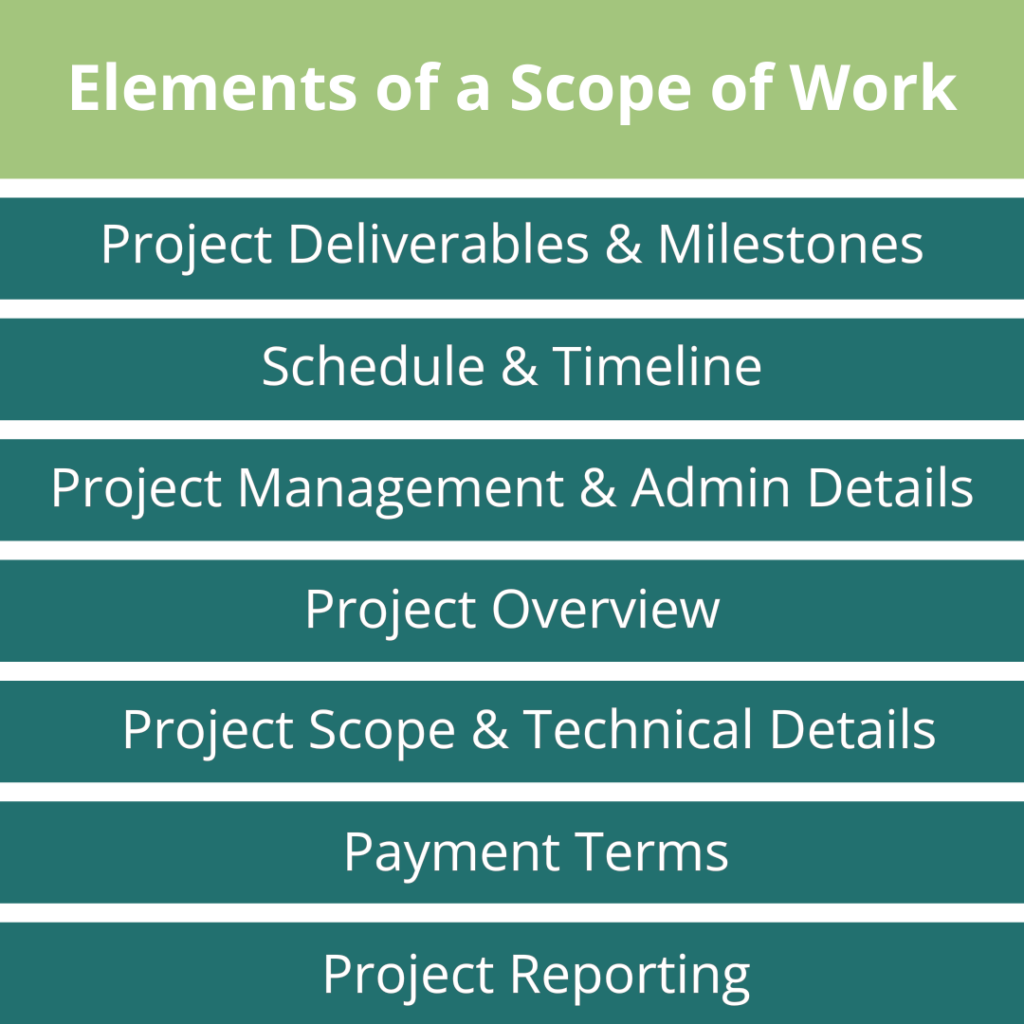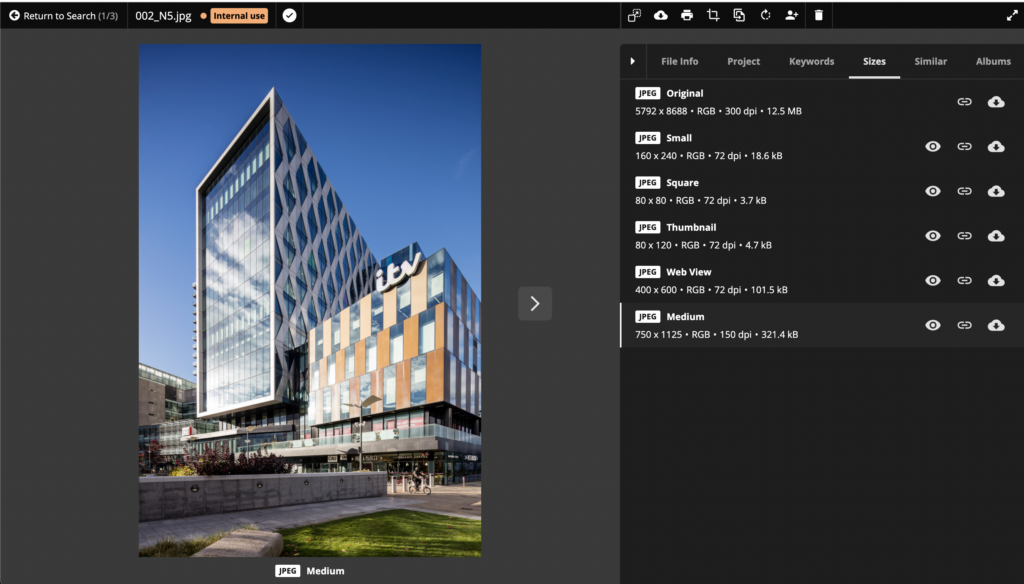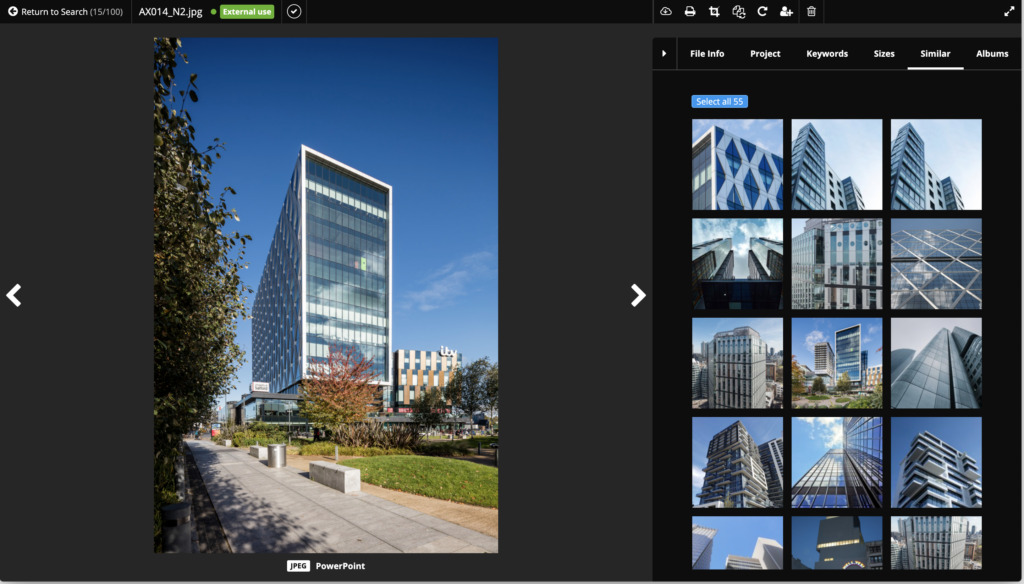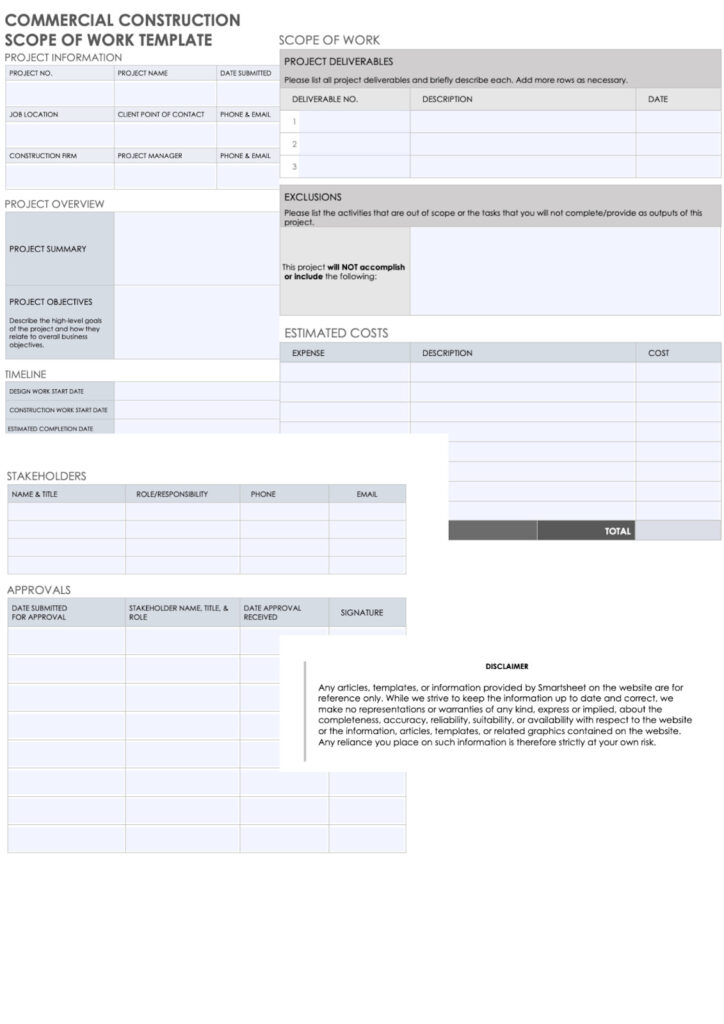An important component of a construction agreement is the construction scope of work (SOW). In the industry, it’s even seen as more important than the agreed-upon price. Without a clear SOW, determining the required tasks and milestones would be impossible. But, what does a construction scope of work include? And how can you write a scope of work?
In this blog, we’re going to give an in-depth look at what each element in a construction scope of work involves and provide you with steps on creating a top SOW for your construction project. Plus, we’ll even tips to apply when drafting your SOW and provide an example of what an effective construction scope of work looks like.
What Is a Scope of Work in Construction?
A Scope of Work (SOW) in construction defines the detailed description of work to be performed for a specific construction project. It provides clear documentation of the work results, processes, and other necessary activities to fulfill the objectives of the project.
The SOW serves as a fundamental document that independent contractors, suppliers, and clients rely on to understand their roles, responsibilities, and expectations throughout the construction process.
Why Is a Scope of Work Important?
A scope of work is highly important in the construction industry for the following reasons:
Outlining the Work Included
A scope of work is crucial as it precisely outlines the project’s trajectory. It provides a clear description of your responsibilities as a worker and offers a detailed definition of the project.
This reduces uncertainty and ensures alignment so that both you and the client enter the project with a shared understanding of roles and timelines.
Preventing Scope Creep
One of the primary advantages of a detailed SOW is the prevention of scope creep. It happens when extra tasks are added to the original project scope while the project is being executed.
By distinctly defining the project boundaries and deliverables, any unplanned changes or additions can be immediately identified and addressed. Scope creep can derail a project’s timeline and budget, making its prevention crucial for successful project delivery.
Managing Expectations
A carefully drafted SOW ensures that all parties involved have a clear and unified understanding of the project’s objectives, responsibilities, and deliverables. This clarity is essential in setting and managing expectations from the beginning.
Can a Scope of Work Be Changed?
Yes, a scope of work can be changed, but such changes typically follow a formal process to ensure transparency, mutual agreement, and effective management.
Changes to the project scope can be initiated through a change request, an important document in project management. Any changes to the scope of work proposed by the contractor must be documented in writing and approved by both parties.
Remember, while changes to the SOW are sometimes necessary, it’s essential to be wary of “scope creep,” where small changes accumulate and lead to significant distractions from the original project plan, potentially derailing its successful completion.
What Is the Difference Between a Proposal and Scope of Work?
Both a proposal and a scope of work (SOW) are integral components of project planning and execution, but they serve different functions and are used at different stages of the client engagement process.
A proposal is typically a document presented to a potential client to win a job or project. It gives an overview of how you will solve your client’s problem(s) and works as an introduction for your client to understand who you are and what you do.
A proposal includes:
- The problem or need identified by the client
- The solution the service provider is offering
- A tentative cost estimate
- A timeline
- Benefits of choosing the said solution
Once the winning proposal is accepted and an agreement is reached to move forward, the SOW provides a detailed and precise description of exactly how the work will be executed.
A project scope of work is not a broad document — it’s a very specific document that outlines every single detail of every individual step of a project you will work on. This includes:
- Expenses for software, materials, and other direct costs
- Deliverables
- Milestones
- Reports
- Hours and payment details for each task
- Project timeline
- A description of every team member’s role and responsibilities
| TIP: Looking for more ways to ensure your construction proposal maximizes every business opportunity? Read our Construction Proposal and RFP Checklist now. |
What Should Be Included in a Scope of Work?
Here’s what each element in your scope of work should include:

Project Deliverables and Milestones
Deliverables refer to what your project delivers. This section should outline all the expected project objectives and goals for the project’s duration. Remember to include sufficient relevant details to give the contractors and subcontractors a clear understanding of the project’s demands.
Moreover, milestones within the scope of work signify critical phases or significant achievements in the project as various tasks reach completion. Rather than pinpointing specific project deliverables, they describe successfully finished project stages.
As a project manager, you have the right to select milestones important to your project, which can include project initiations, meetings, hand-offs, and more.
Schedule and Timeline
This section in the scope of work outlines the primary stages throughout the project’s timeline. A comprehensive timeline specifies start and end dates for the overall project and its phases or tasks.
The timeline in the scope of work is influenced by how complex the construction design is and the agreement established between the project owner and the general contractor. The schedule and timeline aim to provide stakeholders with sufficient information to allow them to plan around project milestones.
This section often includes a visual representation, like a Gantt chart, to provide a clear understanding of the project’s flow and progression.
Project Management and Administration Details
This section of the scope of work should outline the administrative steps related to the project. It provides information about who is managing the project, the governance structure, communication protocols, and any administrative procedures in the construction project.
The administrative details of this section in the scope of work should be related to managing construction procedures, change orders, timeline for payments, and rules implemented during the project. You should also include other relevant contract terms and legal requirements.
Project Overview
The project overview is a concise summary of the project that includes its background, objectives, and significance. It’s important to outline the key objectives that need to be met for the project to be completed successfully. This sets the context and provides a basic understanding for all parties involved.
The project description statement should be brief but clear. This ensures a better chance of the project’s successful completion.
Project Scope and Technical Details
The project scope goes deeper, offering additional details about the tasks and technical aspects linked to each deliverable. In this section, you’ll outline the distinct phases, techniques, and methods that contractors will follow to finish each phase of the project.
In simple terms, project deliverables tell you what the project is while the scope tells you how the project will be executed.
Payment Terms
This section includes the details outlining the payment structure for the project. This includes payment amounts, schedules (e.g., upfront payments, milestone-based payments, completion payments), acceptable payment methods, and any other related financial provisions.
Remember, the project management section is where you should include the details about payments (the payment terms). This includes when and how payments will be made.
Project Reporting
Throughout the project, you’ll create various reports—ranging from status to progress to variance reports—that will be shared with your team, customer, stakeholder, or sponsor.
While these reports formally document your project’s progress, they also serve as a communication tool that goes beyond just tracking whether the project is on schedule. Reporting ensures transparency and keeps all stakeholders informed about the project’s status and any potential challenges.
Customized reports can offer a rich set of data beneficial to multiple audiences. Specify the type of reports you’ll produce, when stakeholders can expect them, and who will be responsible for generating them.
How to Write a Scope of Work for Construction
Writing a construction scope of work is a critical step in project planning and management. A well-structured SOW provides clarity and direction for all involved parties, ensuring that everyone understands their roles, responsibilities, and the project’s goals. Here are some steps you can follow when writing your construction scope of work:
Communicate With the Team and Assign Responsibilities
In any line of work, communication is regarded as a highly important skill. As a project manager, you can promote communication with your team by scheduling weekly meetings to go over project progress and update your team on any relevant modifications. Plus, it can be helpful to ensure each person on your team has the resources they need to access important information.
Once you’ve established how to practice effective communication among the team, you’ll want to assign the right work to the right people. Whether you’re putting someone in charge of materials or rental equipment, it’s best to start assigning responsibilities as soon as possible.
Not doing so can cause confusion and delays, ultimately negatively impacting your final project. Assigning responsibilities early on reduces the chances of facing unnecessary bumps along the road.
Break Down the Objectives and Deliverables
With so many different elements making up a construction scope of work, it can become confusing to deal with all the complex and endless information and deliverables. Therefore, it only makes sense that you’ll want to make the process easier. How can you do that? By breaking down the work.
When writing your construction scope of work, it’s important to define your project objectives and identify all your project tasks. To break this down, use a work breakdown structure (WBS). A WBS is a project management tool that allows you to break down projects and work packages into discrete tasks, improving planning and scheduling.
You can begin crafting a WBS by writing down your goals and milestones. Next, outline the specific phases and tasks to be completed. This process will provide clarity to everyone involved about the essential aspects of your construction process.
Get Sign-Offs
Writing a construction scope of work requires not only the client’s approval signature but also written sign-offs from the team members (like contractors and subcontractors) and stakeholders (like designers) responsible for the deliverables mentioned in the SOW. You also have the option to let the team sign whenever they achieve a personal goal or milestone.
Not only is this a way to avoid confusion on who is responsible for what task, but, most importantly, it’s a simple (yet crucial) step to avoid any potential disputes with the involved parties or to avoid scope creep that can jeopardize the project.
Having team members sign the document confirms that they have read and understood their responsibilities. Therefore, when everyone agrees on the main points and objectives, it helps prevent problems if there’s a disagreement later.
Tips for Your Construction Scope of Work
Writing a scope of work demands careful consideration of every project phase. The more detailed the document, the higher the likelihood of a successful project. However, before you begin writing your construction scope of work, consider applying the following tips:
Use Strong Visuals
Did you know that 90% of the information processed by our brains is visual? Recent research found that the human brain can process an image in only 13 milliseconds. Visual aids such as project images and mock-ups can be more descriptive than words alone.
Visual representations can simplify complex processes or structures, helping stakeholders visualize the project’s path. Moreover, visuals can break up text-heavy sections, making the document more reader-friendly.
When managing endless digital assets for your construction project, you need a digital asset management (DAM) system. With a DAM, construction teams can easily access up-to-date blueprints, designs, and documents, while also benefiting from version control. Its centralized approach reduces confusion, saves time, and fosters better communication among project stakeholders.

Source: homeedit

Source: homeedit

Source: homeedit


Use Clear Language
While it might be tempting to use technical jargon, it’s essential to remember that not everyone reading the construction scope of work will be familiar with industry-specific terms. Use plain and straightforward language whenever possible.
If technical terms are unavoidable, consider adding a glossary or footnotes for clarity. The goal is to share pertinent details concisely.
Define Realistic Goals
While ambition is admirable, it’s important to make sure that the goals set out in your construction scope of work are achievable within the given constraints, be it time, resources, or budget. This can include the needed materials and work tied to specific tasks or milestones.
Unrealistic goals can lead to unmet expectations, project delays, and potential disputes. It’s always better to under-promise and over-deliver.
Set Clear Expectations
A successful SOW leaves no room for ambiguity. Every task, responsibility, and deliverable should be outlined clearly, specifying who is responsible for what. This not only ensures accountability but also provides a roadmap for all involved, ensuring everyone is on the same page.
Construction scope of work example
Now that we’ve looked at the different elements and sections of a construction scope of work and how to write one, let’s see it in action.

Source: smartsheet
To help you further understand the significance and role of a scope of work in construction, consider the straightforward example of building a residential home. Here you can see what the scope of work information would look like:
Construction Scope of Work: Residential Home Build
1. Proposal Overview:
- Objective: Construct a 3-bedroom, 2-bathroom single-family residence at [Address], with a total built-up area of approximately 2,000 square feet.
- Client: Mr. and Mrs. Smith
- Contractor: XYZ Construction Company
2. Project Scope and Technical Details:
- Foundation: Reinforced concrete slab-on-grade foundation with integrated footings.
- Framing: Wooden framing for walls, floors, and roof.
- Exterior: Brick facade on the first floor, vinyl siding on the second.
- Roofing: Asphalt shingles with a 25-year warranty.
- Interior: Drywall partitions, hardwood flooring in living areas, tile in bathrooms and kitchen.
- Utilities: Installation of electrical, plumbing, and HVAC systems per local codes.
- Landscaping: Basic lawn with a concrete driveway and pathway.
3. Project Deliverables and Milestones:
- Site Preparation: Land clearing, excavation, and soil testing.
- Foundation Laying: Pouring and setting of the concrete foundation.
- Framing Completion: Structural framing of the entire house.
- Roof Installation: Application of roofing materials.
- Utilities Installation: Completion of electrical, plumbing, and HVAC systems.
- Interior Finishing: Painting, flooring, cabinetry, and fixture installations.
- Final Inspection and Handover: Once all construction tasks are complete.
4. Schedule and Timeline:
- Site Preparation: June 1 – June 7
- Foundation Laying: June 8 – June 15
- Framing Completion: June 16 – June 30
- Roof Installation: July 1 – July 7
- Utilities Installation: July 8 – July 20
- Interior Finishing: July 21 – August 10
- Final Inspection and Handover: August 15
5. Project Management and Administration Details:
- Project Manager: John Doe from XYZ Construction Company.
- Key Contacts: Jane Doe (Site Supervisor) and Mr. Smith (Client).
- Communication: Weekly progress meetings every Monday at 10 a.m. at the construction site.
- Permits: All necessary permits are to be obtained by XYZ Construction Company.
6. Payment Terms:
- Initial Deposit: 10% upon signing the contract.
- Milestone Payments:
- Foundation Laying: 15%
- Framing Completion: 20%
- Roof Installation: 15%
- Utilities Installation: 20%
- Interior Finishing: 15%
- Final Payment: 5% after final inspection and handover.
7. Project Reporting Information:
- Frequency: Weekly reports every Friday.
- Contents: Progress summary, upcoming week’s schedule, any challenges or changes, and updated photographs.
- Delivery: Email reports to Mr. and Mrs. Smith and any other designated stakeholders.
These examples can serve as a simple template to help you understand what sections and information to include in the construction scope of work. The specific details and complexities would vary based on the size of the construction project, client preferences, and other unique factors.
How to Create a Winning Construction SOW With Proposal Software
In the construction industry, crafting a winning scope of work is important for any construction project. However, creating quality project scope of work documents over and over again isn’t an easy task. Luckily, with the #1 DAM for AEC and Real Estate, OpenAsset, creating SOW documents can be easier. OpenAsset software helps you find, share, and use the digital assets you need to create high-quality AEC proposals and SOW documents quickly and easily.
OpenAsset centralizes all project-related assets, ensuring assets are accurate and up-to-date. Its customizable templates offer consistency, while collaboration tools invite different perspectives into the drafting process.
Combined with advanced search capabilities and offering seamless integrations with other project management tools, OpenAsset ensures precision, collaboration, and efficiency in framing a construction project’s scope of work. Given its tailored features, OpenAsset stands as an outstanding ally for the construction sector, streamlining proposal preparations.
If you’d like to learn more about how our DAM technology can help you create effective SOW documents, you can reach out to one of our digital asset experts today.



